Economical Assessment of Recycled Asphalt Pavement (RAP) Aggregate for Structural Concrete Production in Italy
Abstract
:1. Introduction
2. Materials and Methods
2.1. Aggregate Production Analysis
2.2. Case Study
2.3. Mix Design
- Rm28 is the actual compression strength evaluated at 28 days [N/mm2];
- Rck is the characteristic compressive strength, which in this case is equal to 35 [N/mm2].
2.4. Cost Evaluation
- UPi is the unit price of apparatus i [€];
- Ni is the number of items needed for machine i;
- l is the useful life of the plant, hypothesized to be equal to 20 years.
- Po is the price of crude oil [€/kg], equal to 0.618 €/kg [68];
- PED is the primary energy specific demand [kgoe/ton], calculated as it follows:
- FPEF is the final to primary energy factor, equal to 0.086 for diesel and to 0.29 for electricity [52];
- FED is the final energy consumption [kWh/ton], which is equal to the final energy demand and is calculated in accordance with:
- Pi is the effective power of apparatus [kW], obtained by multiplying machine power for efficiency factor;
- R is the production capacity of the plant hypothesized to be 200 ton/h.
- Ch is the sum of the maintenance cost of each apparatus per year, [€/year];
- Cw is the sum of the yearly wages, [€/year];
- d is the number of plant activated days per year, hypothesized to be 300 days;
- h is the number of activated hours per day, hypothesized to be 8 h.
3. Results
3.1. Aggregate Production Analysis
3.1.1. Phase 1: Material Acquisition
3.1.2. Phase 2: EoW Process
- P2.R.O1: Check of waste entering the recycling plant to verify the absence of other materials;
- P2.R.O2: Test aimed at searching for asbestos, one sample every 3000 m3 of material;
- P2.R.O3: Test aimed at searching for polycyclic aromatic hydrocarbons PAH, one sample every 3000 m3 of material;
- P2.R.O4: Leaching test according to the methods described in Annex 3 of the 5 February 1998 Ministerial Decree published by the Ministry of the Environment, one sample every 3000 m3 of material;
- P2.R.O5: Determination of particle size distribution according to EN 933-1;
- P2.R.O6: Petrographic description according to the procedures of EN 932-3.
3.1.3. Phase 3: By-Product/Raw Material Transformation
3.1.4. Phase 4: Aggregate Essential Characteristics Assessment
3.1.5. Phase 5: Transport
3.2. Cost Evaluation
3.2.1. Total Costs
3.2.2. Unit Costs
- RAP.f: obtained combining no fees with reduced distance strategy; this would lead to a unit cost of 84.51 €/m3, inducing a reduction of −61.10%;
- RAP.g: obtained combining the same operator with reduced distance strategy; this would imply a unit cost of 93.00 €/m3 reducing RAP unit cost by −57.20%;
- RAP.h: obtained by combining no fees and the same operator with a reduced distance strategy; this would lead to a unit cost of 51.35 €/m3, causing a reduction of −76.36%.
4. Discussion
5. Conclusions
- Currently RAP aggregate for structural production in Italy is not a competitive option in terms of cost, being +155.39% higher than NA aggregate one;
- The higher cost is caused by three RAP aggregate production phases: namely acquisition (P1.R), End of Waste process (P2.R) and transport (P5.R);
- On the other hand, two RAP production phases, transformation (P3.R) and assessment (P4.R) are characterized by a positive cost reduction when confronted with the corresponding NA ones. The reductions are equal to −41.91% for the transformation phase and −31.80% for the assessment phase;
- With respect to acquisition (P1.R) two operations were accountable for the high price, namely asphalt milling (P1.R.O1) and recycling fees payment (P1.R.O4);
- Concerning transport (P5.R) the accountant for the high cost was the transport to the concrete plant operation due to the long distance between the construction site and the RAP transformation plant.
- Acting solely on one of the operations responsible for RAP aggregate high cost is not sufficient in order to grant this material competitiveness;
- The only possibility of having an appreciable cost reduction is acting contemporarily on the three critical operations. This would lead to a competitive RAP aggregate unit cost, implying a cost reduction of −39.64% with respect to NA cost and of 45.13%-67.30% reduction with respect to RCA one.
Author Contributions
Funding
Data Availability Statement
Conflicts of Interest
Appendix A
| N. | Characteristic | Standard | NA | RA |
|---|---|---|---|---|
| T.1 | Particle size | EN 933-1 | X | X |
| T.2 | Grading | EN 933-1 | X | X |
| T.3 | Shape of coarse aggregate | EN 933-3 | X | X |
| T.4 | Particle density and water absorption | EN 1097-6 | X | X |
| T.5 | Shell content of coarse aggregate | EN 933-7 | X | - 1 |
| T.6 | Fines content | EN 933-1 | X | X |
| T.7 | Fines quality: methylene blue | EN 933-9 | X | X |
| T.8 | Resistance to fragmentation of coarse aggregate | EN 1097-2 | X | - 2 |
| T.9 | Resistance to wear of coarse aggregate | EN 1097-1 | X | - 2 |
| T.10 | Resistance to polishing | EN 1097-8 | X | - 2 |
| T.11 | Resistance to surface abrasion | EN 1097-8 | X | - 2 |
| T.12 | Resistance to abrasion from studded tyres | EN 1097-9 | X | - 2 |
| T.13 | Constituent of coarse recycled aggregates | prEN 933-11 | - | X |
| T.14 | Water-soluble chlorides content | EN 1744-1 | X | X |
| T.15 | Acid-soluble chlorides content (recycled aggregates) | EN 1744-5 | - | X |
| T.16 | Acid-soluble sulphates content | EN 1744-1 | X | X |
| T.17 | Total sulphur content | EN 1744-1 | X | X |
| T.18 | Water-soluble sulphate content of recycled aggregate | EN 1744-1 | - | X |
| T.19 | Constituents of natural aggregate which alter the rate of setting and hardening of concrete | EN 1744-6 | X | - 3 |
| T.20 | Influence on initial and final setting time of cement | EN 1744-1 | X | - 4 |
| T.21 | Influence on initial and final setting time of cement (recycled aggregates) | EN 1744-6 | - | X |
| T.22 | Carbonate content of fine aggregate for concrete pavement surface course | EN 1744-1 | X | - 2 |
| T.23 | Volume stability—drying shrinkage | EN 1367-4 | X | X |
| T.24 | Constituents which affect the volume stability of air cooled blast furnace slag | 1744-1 | - 5 | - 5 |
| T.25 | Freeze/thaw resistance of coarse aggregate | EN 1367-1 | X | X |
| T.26 | Freeze/thaw resistance of coarse aggregate | EN 1367-6 | X | X |
| T.27 | Alkali-silica reactivity | UNI 8520-22 6 | X | X |
| T.28 | Dangerous substances | 7 | - | - |
References
- Philips Adebowale, A.; Asa Olusola, A.; Omotehinse Olusegun, J.; Ikpeme Anthony, A.; Ibrahim Dabara, D. The need for green building rating systems. Acad. J. Sci. 2017, 7, 35–44. [Google Scholar]
- United Nation Environmental Programme. 2021 Global Status Report for Buildings and Construction Sector: Towards a Zero-Emissions, Efficient and Resilient Building and Construction Sector; United Nation Environmental Programme: Nairobi, Kenya, 2021. [Google Scholar]
- de Brito, J.; Kurda, R. The past and future of sustainable concrete: A critical review and new strategies on cement-based materials. J. Clean. Prod. 2021, 281, 123558. [Google Scholar] [CrossRef]
- Marvila, M.; de Matos, P.; Rodriguez, E.; Monteiro, S.N.; de Azevedo, A.R.G. Recycled Aggregate: A Viable Solution for Sustainable Concrete Production. Materials 2022, 15, 5276. [Google Scholar] [CrossRef] [PubMed]
- Singh, V.K.; Shukla, A.; Sahani, R.K.; Shekhar, A.R.; Singh, R. Structural Application of Concrete Made of Recycled Aggregate Sourced from Construction and Demolition Waste. In Proceedings of the SECON’21; Springer: Berlin/Heidelberg, Germany, 2022; pp. 863–872. [Google Scholar]
- Kang, D.-H.; Gupta, S.C.; Ranaivoson, A.Z.; Siekmeier, J.; Roberson, R. Recycled Materials as Substitutes for Virgin Aggregates in Road Construction: I. Hydraulic and Mechanical Characteristics. Soil Sci. Soc. Am. J. 2011, 75, 1265–1275. [Google Scholar] [CrossRef]
- Chinnu, S.N.; Minnu, S.N.; Bahurudeen, A.; Senthilkumar, R. Recycling of industrial and agricultural wastes as alternative coarse aggregates: A step towards cleaner production of concrete. Constr. Build. Mater. 2021, 287, 123056. [Google Scholar] [CrossRef]
- Zulkernain, N.H.; Gani, P.; Chuck Chuan, N.; Uvarajan, T. Utilisation of plastic waste as aggregate in construction materials: A review. Constr. Build. Mater. 2021, 296, 123669. [Google Scholar] [CrossRef]
- Manjunatha, M.; Seth, D.; Balaji, K.V.G.D.; Bharath, A. Engineering properties and environmental impact assessment of green concrete prepared with PVC waste powder: A step towards sustainable approach. Case Stud. Constr. Mater. 2022, 17, e01404. [Google Scholar] [CrossRef]
- Harrison, E.; Berenjian, A.; Seifan, M. Recycling of waste glass as aggregate in cement-based materials. Environ. Sci. Ecotechnol. 2020, 4, 100064. [Google Scholar] [CrossRef]
- de Andrade Salgado, F.; de Andrade Silva, F. Recycled aggregates from construction and demolition waste towards an application on structural concrete: A review. J. Build. Eng. 2022, 52, 104452. [Google Scholar] [CrossRef]
- Magbool, H.M. Utilisation of ceramic waste aggregate and its effect on Eco-friendly concrete: A review. J. Build. Eng. 2022, 47, 103815. [Google Scholar] [CrossRef]
- Joyklad, P.; Ali, N.; Chaiyasarn, K.; Poovarodom, N.; Yooprasertchai, E.; Maqbool, H.M.; Ruangrassamee, A.; Hussain, Q. Improvement of stress-strain behavior of brick-waste aggregate concrete using low-cost FCSM composites. Constr. Build. Mater. 2022, 351, 128946. [Google Scholar] [CrossRef]
- Singh, N.; Singh, A.; Ankur, N.; Kumar, P.; Kumar, M.; Singh, T. Reviewing the properties of recycled concrete aggregates and iron slag in concrete. J. Build. Eng. 2022, 60, 105150. [Google Scholar] [CrossRef]
- Nandi, S.; Ransinchung, G.D.R.N. Performance evaluation and sustainability assessment of precast concrete paver blocks containing coarse and fine RAP fractions: A comprehensive comparative study. Constr. Build. Mater. 2021, 300, 124042. [Google Scholar] [CrossRef]
- Singh, S.; Ransinchung, G.D.; Kumar, P. An economical processing technique to improve RAP inclusive concrete properties. Constr. Build. Mater. 2017, 148, 734–747. [Google Scholar] [CrossRef]
- Zhang, J.; Zhang, X.; Liang, M.; Jiang, H.; Wei, J.; Yao, Z. Influence of different rejuvenating agents on rheological behavior and dynamic response of recycled asphalt mixtures incorporating 60% RAP dosage. Constr. Build. Mater. 2020, 238, 117778. [Google Scholar] [CrossRef]
- Zaumanis, M.; Mallick, R.B.; Frank, R. 100% recycled hot mix asphalt: A review and analysis. Resour. Conserv. Recycl. 2014, 92, 230–245. [Google Scholar] [CrossRef]
- Dunn, I.P.; Acuto, F.; Yazoghli-Marzouk, O.; Di Mino, G.; Mantalovas, K. Increasing the Use of Reclaimed Asphalt in Italy towards a Circular Economy: A Top-Down Approach. Eng. Proc. 2022, 17, 25. [Google Scholar]
- Jaawani, S.; Franco, A.; De Luca, G.; Coppola, O.; Bonati, A. Limitations on the Use of Recycled Asphalt Pavement in Structural Concrete. Appl. Sci. 2021, 11, 10901. [Google Scholar] [CrossRef]
- EAPA. Asphalt in Figures 2019; The European Asphalt Pavement Association: Brussels, Belgium, 2019. [Google Scholar]
- Masi, G.; Michelacci, A.; Manzi, S.; Bignozzi, M.C. Assessment of reclaimed asphalt pavement (RAP) as recycled aggregate for concrete. Constr. Build. Mater. 2022, 341, 127745. [Google Scholar] [CrossRef]
- ANAS, S.p.A. Capitolato Speciale di Appalto. Norme Tecniche per l’esecuzione del Contratto Parte 2; ANAS S.p.A.: Rome, Italy, 2017. [Google Scholar]
- Domenichini, L.; Di Mascio, P.; Giannattasio, C.; Caliendo, C.; Festa, B.; Marchionna, A.; Firmi, P.; Molinaro, E.; Paoloni, G. Modello di Catalogo delle Pavimentazioni Stradali; Giannini: Naples, Italy, 1993. [Google Scholar]
- Ministero della Transizione Ecologica. Regolamento che Disciplina la Cessazione della Qualifica di Rifiuto dei Rifiuti Inerti da Costruzione e Demolizione e di Altri Rifiuti Inerti di Origine Minerale, ai Sensi Dell’articolo 184-ter, Comma 2, del Decreto Legislativo 3 Aprile 2006, n. 152. 2022; Ministero della Transizione Ecologica: Rome, Italy, 2022. [Google Scholar]
- UNI 8520-1; Aggregates for Concrete—Additional Provisions for the Application of EN 12620—Part 1: Designation and Conformity Criteria 2022. UNI Ente Italiano di Normazione: Milan, Italy, 2005.
- UNI 8520-2; Aggregates for Concrete—Additional Provisions for the Application of EN 12620—Part 2: Requirements 2022. UNI Ente Italiano di Normazione: Milan, Italy, 2016.
- Ministero delle Infrastrutture e dei Trasporti. Aggiornamento delle Norme Tecniche per le Costruzioni; Ministero delle Infrastrutture e dei Trasporti: Rome, Italy, 2018. [Google Scholar]
- Huang, B.; Shu, X.; Li, G. Laboratory investigation of portland cement concrete containing recycled asphalt pavements. Cem. Concr. Res. 2005, 35, 2008–2013. [Google Scholar] [CrossRef]
- Papakonstantinou, C.G. Resonant column testing on Portland cement concrete containing recycled asphalt pavement (RAP) aggregates. Constr. Build. Mater. 2018, 173, 419–428. [Google Scholar] [CrossRef]
- Erdem, S.; Blankson, M.A. Environmental performance and mechanical analysis of concrete containing recycled asphalt pavement (RAP) and waste precast concrete as aggregate. J. Hazard. Mater. 2014, 264, 403–410. [Google Scholar] [CrossRef] [PubMed]
- Pokorny, J.; Sevcik, R.; Sal, J. The Design and Material Characterization of Reclaimed Asphalt Pavement Enriched Concrete for Construction Purposes. Materials 2020, 13, 4986. [Google Scholar] [CrossRef] [PubMed]
- Huang, B.; Shu, X.; Burdette, E.G. Mechanical properties of concrete containing recycled asphalt pavements. Mag. Concr. Res. 2006, 58, 313–320. [Google Scholar] [CrossRef]
- Thomas, R.J.; Fellows, A.J.; Sorensen, A.D. Durability Analysis of Recycled Asphalt Pavement as Partial Coarse Aggregate Replacement in a High-Strength Concrete Mixture. J. Mater. Civ. Eng. 2018, 30, 04018061. [Google Scholar] [CrossRef]
- Khodair, Y.; Luqman. Self-compacting concrete using recycled asphalt pavement and recycled concrete aggregate. J. Build. Eng. 2017, 12, 282–287. [Google Scholar] [CrossRef]
- Singh, S.; Ransinchung, G.D.R.N.; Debbarma, S.; Kumar, P. Utilization of reclaimed asphalt pavement aggregates containing waste from Sugarcane Mill for production of concrete mixes. J. Clean. Prod. 2018, 174, 42–52. [Google Scholar] [CrossRef]
- Arabiyat, S.; Abdel Jaber, M.; Katkhuda, H.; Shatarat, N. Influence of using two types of recycled aggregates on shear behavior of concrete beams. Constr. Build. Mater. 2021, 279, 122475. [Google Scholar] [CrossRef]
- Abedalqader, A.; Shatarat, N.; Ashteyat, A.; Katkhuda, H. Influence of temperature on mechanical properties of recycled asphalt pavement aggregate and recycled coarse aggregate concrete. Constr. Build. Mater. 2021, 269, 121285. [Google Scholar] [CrossRef]
- Alrajfi, E.; Ashteyat, A.M.; Murad, Y.Z. Shear behaviour of RC beams made with natural, recycled aggregate concrete and reclaimed asphalt aggregates under normal and elevated temperature. J. Build. Eng. 2021, 40, 102681. [Google Scholar] [CrossRef]
- Sahan, M.F.; Unsal, I. An Experimental Analysis for Impact Behavior of Portland Cement Concrete Substituted with Reclaimed Asphalt Pavement Aggregate. Iran. J. Sci. Technol. Trans. Civ. Eng. 2023, 47, 2113–2130. [Google Scholar] [CrossRef]
- Ben Saïd, S.E.E.; Euch Khay, S.E.; Achour, T.; Loulizi, A. Modelling of the adhesion between reclaimed asphalt pavement aggregates and hydrated cement paste. Constr. Build. Mater. 2017, 152, 839–846. [Google Scholar] [CrossRef]
- Singh, S.; Ransinchung, G.D.R.N.; Kumar, P. Feasibility study of RAP aggregates in cement concrete pavements. Road Mater. Pavement Des. 2017, 20, 151–170. [Google Scholar] [CrossRef]
- Singh, S.; Shintre, D.; Ransinchung, G.D.R.N.; Kumar, P. Performance of Fine RAP Concrete Containing Flyash, Silica Fume, and Bagasse Ash. J. Mater. Civ. Eng. 2018, 30, 04018233. [Google Scholar] [CrossRef]
- Getahun, M.; Shitote, S.; Gariy, Z. Experimental Investigation on Engineering Properties of Concrete Incorporating Reclaimed Asphalt Pavement and Rice Husk Ash. Buildings 2018, 8, 115. [Google Scholar] [CrossRef]
- Soltanabadi, R.; Behfarnia, K. Evaluation of Mechanical Properties of Concrete Containing Recycled Concrete Aggregate and Recycled Asphalt Pavement. J. Mater. Civ. Eng. 2022, 34, 04022348. [Google Scholar] [CrossRef]
- Soltanabadi, R.; Behfarnia, K. Shear strength of reinforced concrete deep beams containing recycled concrete aggregate and recycled asphalt pavement. Constr. Build. Mater. 2022, 314, 125597. [Google Scholar] [CrossRef]
- Shatarat, N.; Alhaq, A.A.; Katkhuda, H.; Jaber, M.A. Investigation of axial compressive behavior of reinforced concrete columns using Recycled Coarse Aggregate and Recycled Asphalt Pavement aggregate. Constr. Build. Mater. 2019, 217, 384–393. [Google Scholar] [CrossRef]
- Wang, Y.; Liao, J.; Liu, Z. Service life prediction and environmental impact evaluation of recycled aggregate concrete with supplementary cementitious materials. Constr. Build. Mater. 2023, 395, 132270. [Google Scholar] [CrossRef]
- Xiao, F.; Su, N.; Yao, S.; Amirkhanian, S.; Wang, J. Performance grades, environmental and economic investigations of reclaimed asphalt pavement materials. J. Clean. Prod. 2019, 211, 1299–1312. [Google Scholar] [CrossRef]
- Jahanbakhsh, H.; Karimi, M.M.; Naseri, H.; Nejad, F.M. Sustainable asphalt concrete containing high reclaimed asphalt pavements and recycling agents: Performance assessment, cost analysis, and environmental impact. J. Clean. Prod. 2020, 244, 118837. [Google Scholar] [CrossRef]
- Tam, V.W.Y. Economic comparison of concrete recycling: A case study approach. Resour. Conserv. Recycl. 2008, 52, 821–828. [Google Scholar] [CrossRef]
- Ghanbari, M.; Monir Abbasi, A.; Ravanshadnia, M. Economic and Environmental Evaluation and Optimal Ratio of Natural and Recycled Aggregate Production. Adv. Mater. Sci. Eng. 2017, 2017, 7458285. [Google Scholar] [CrossRef]
- Ghanbari, M.; Abbasi, A.M.; Ravanshadnia, M. Production of natural and recycled aggregates: The environmental impacts of energy consumption and CO2 emissions. J. Mater. Cycles Waste Manag. 2017, 20, 810–822. [Google Scholar] [CrossRef]
- EN 206; Concrete—Specification, Performance, Production and Conformity 2021. European Committee for Standardization: Brussels, Belgium, 2000.
- ANAS S.p.A. I Quaderni Tecnici per la Salvaguardia delle Infrastrutture Volume 5 Rome; ANAS S.p.A.: Rome, Italy, 2019. [Google Scholar]
- Pavimental, S.p.A. Dichiarazione di Prestazione Aggregato Granulato di Conglomerato Bituminoso 2022. Available online: https://www.ampliaspa.it/documenti_tecnici.php (accessed on 24 September 2022).
- Benocci, C. Dichiarazione di Prestazione Aggregato per Calcestruzzo. 2022. Available online: http://www.benoccispa.it/it/graniglia-calcarea-20-12620.html (accessed on 24 September 2022).
- UNI 11104; Concrete—Specification, Performance, Production and Conformity—Additional Provisions for the Application of EN 206. Ente Italiano di Normazione (UNI): Milan, Italy, 2016.
- Redaelli, E.; Carsana, M.; Filippi, A.; Lollini, F. Preliminary characterization of concrete made with RAP aggregate. In Proceedings of the 15th International Conference on Recent Advances in Concrete Technology and Sustainability Issues (RACTSI), Milan, Italy, 13–15 July 2022; pp. 201–212. [Google Scholar]
- Holcim. CEM II/A-LL 42,5 R; Holcim: Como, Italy, 2022. [Google Scholar]
- Regione Lombardia. Prezzario Regionale delle Opere Pubbliche—Vol. 1.1 Opere Compiute Civili, Urbanizzazione e Difesa del Suolo; Regione Lombardia: Milan, Italy, 2022. [Google Scholar]
- Regione Lombardia. Prezzario Regionale delle Opere Pubbliche—Vol. 2.1 Costi Unitari e Piccola Manutenzione Civili e Urbanizzazione; Regione Lombardia: Milan, Italy, 2022. [Google Scholar]
- ALIG. Tariffario Generale; ALIG: Rome, Italy, 2015. [Google Scholar]
- Università degli Studi di Bari Aldo Moro. Tariffario per Analisi Conto Terzi; Università degli Studi di Bari Aldo Moro: Bari, Italy, 2022. [Google Scholar]
- TFB. Catalogue de Services. Available online: https://www.tfbshop.ch/shop-fr/index.html (accessed on 26 September 2022).
- Banca d’Italia. Cambi di Riferimento del 31 Dicembre 2018. Available online: https://www.bancaditalia.it/compiti/operazioni-cambi/cambio/cambi_rif_20181231/?dotcache=refresh (accessed on 24 September 2022).
- Istat. Rivaluta—Rivalutazioni e Documentazioni su Prezzi, Costi e Retribuzioni Contrattuali. Available online: https://rivaluta.istat.it/Rivaluta/ (accessed on 24 September 2022).
- OilPrice. Oil Prices. Available online: https://oilprice.com/ (accessed on 23 September 2022).
- Ministero dell’Ambiente e della Tutela del Territorio e del Mare. Regolamento Recante Disciplina della Cessazione della Qualifica di Rifiuto di Conglomerato Bituminoso ai Sensi Dell’art. 184-ter, Comma 2 del Decreto Legislativo 2 Aprile 2006, n. 152; Ministero dell’Ambiente e della Tutela del Territorio e del Mare: Rome, Italy, 2018. [Google Scholar]
- EN 12620; Aggregates for Concrete. European Committee for Standardization: Brussels, Belgium, 2008.
- Wirtgen Group. Cold Milling Machine W 1900; Wirtgen Group: Windhagen, Germany, 2022. [Google Scholar]
- Ma, M.; Tam, V.W.Y.; Le, K.N.; Osei-Kyei, R. Factors affecting the price of recycled concrete: A critical review. J. Build. Eng. 2022, 46, 103743. [Google Scholar] [CrossRef]
- Moro, C.; Francioso, V.; Lopez-Arias, M.; Velay-Lizancos, M. CO2 curing of mortar with natural and recycled concrete aggregate: An environmental and economic assessment. Constr. Build. Mater. 2023, 399, 132587. [Google Scholar] [CrossRef]
- Katerusha, D. Investigation of the optimal price for recycled aggregate concrete—An experimental approach. J. Clean. Prod. 2022, 365, 132857. [Google Scholar] [CrossRef]

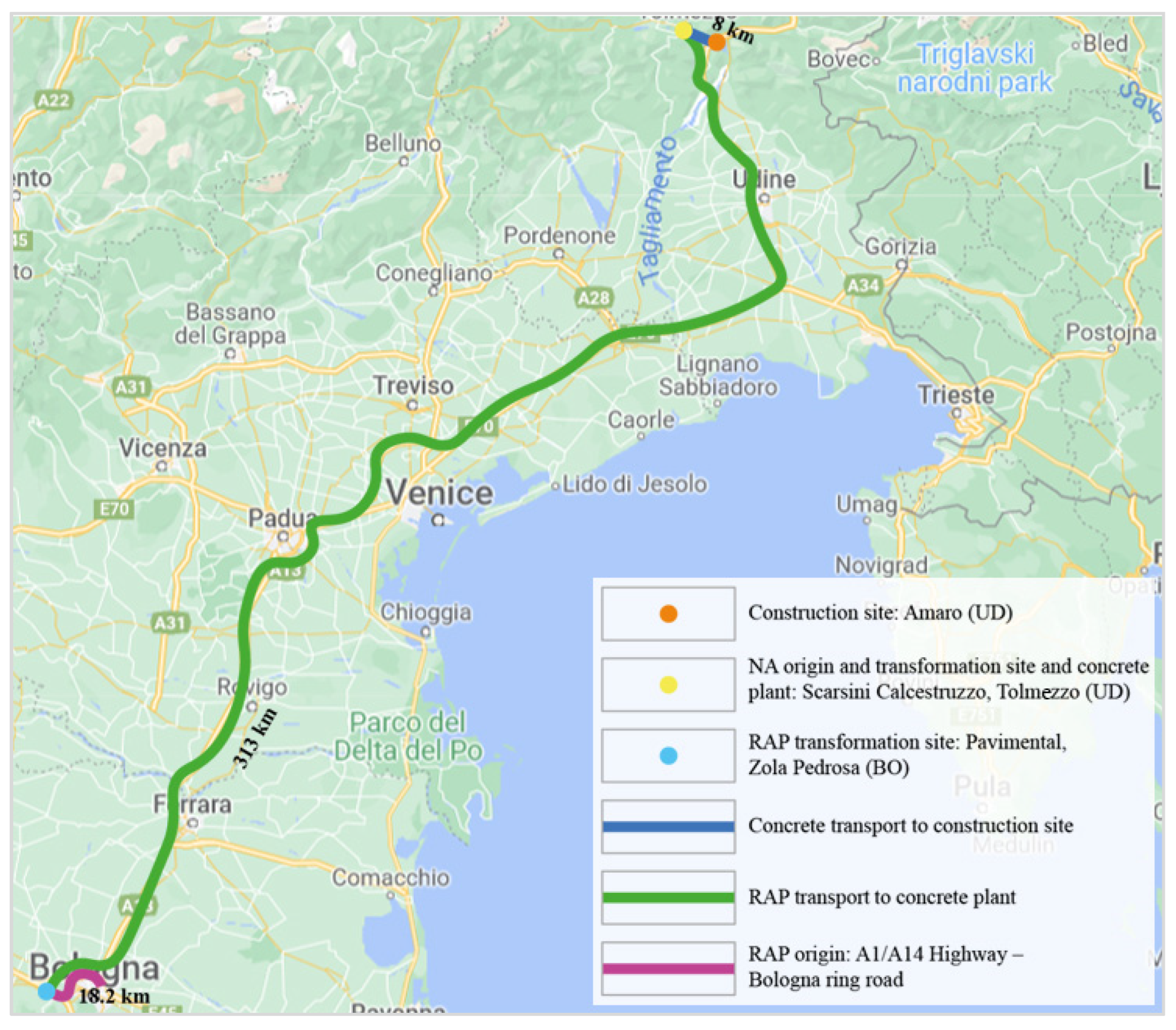


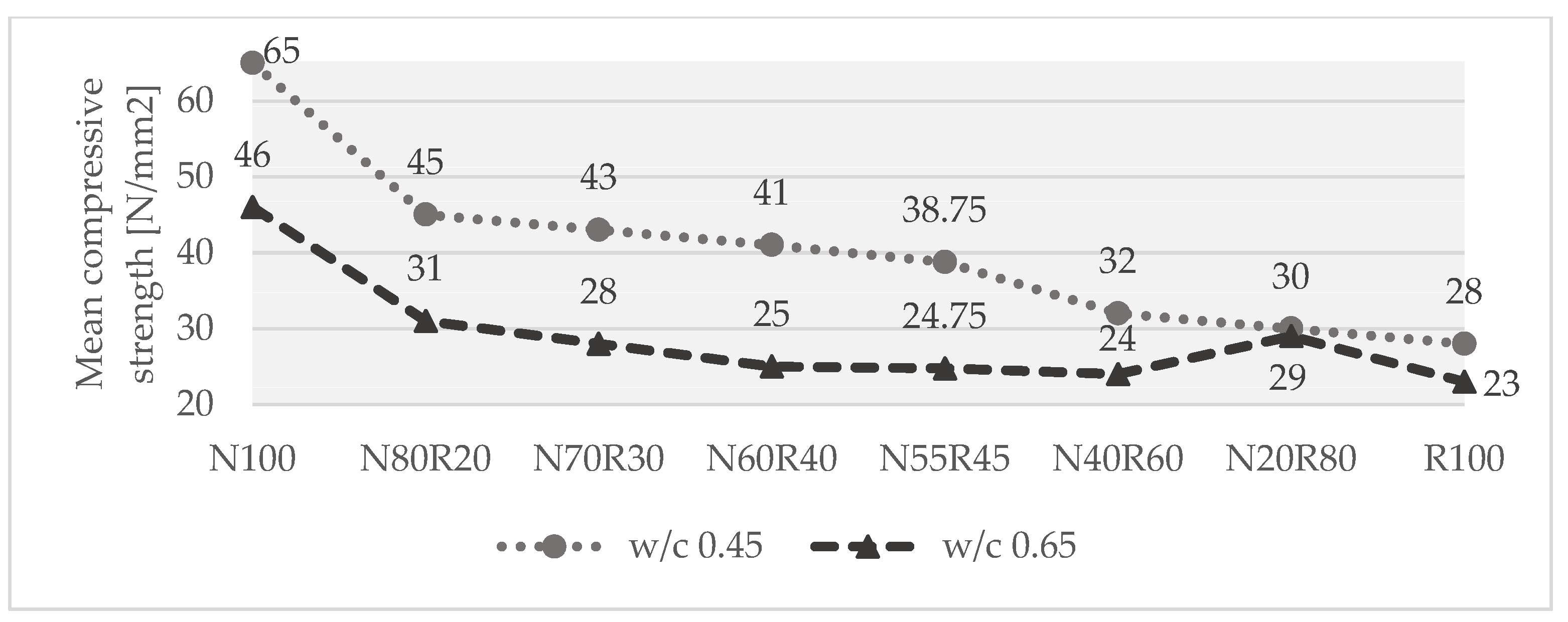
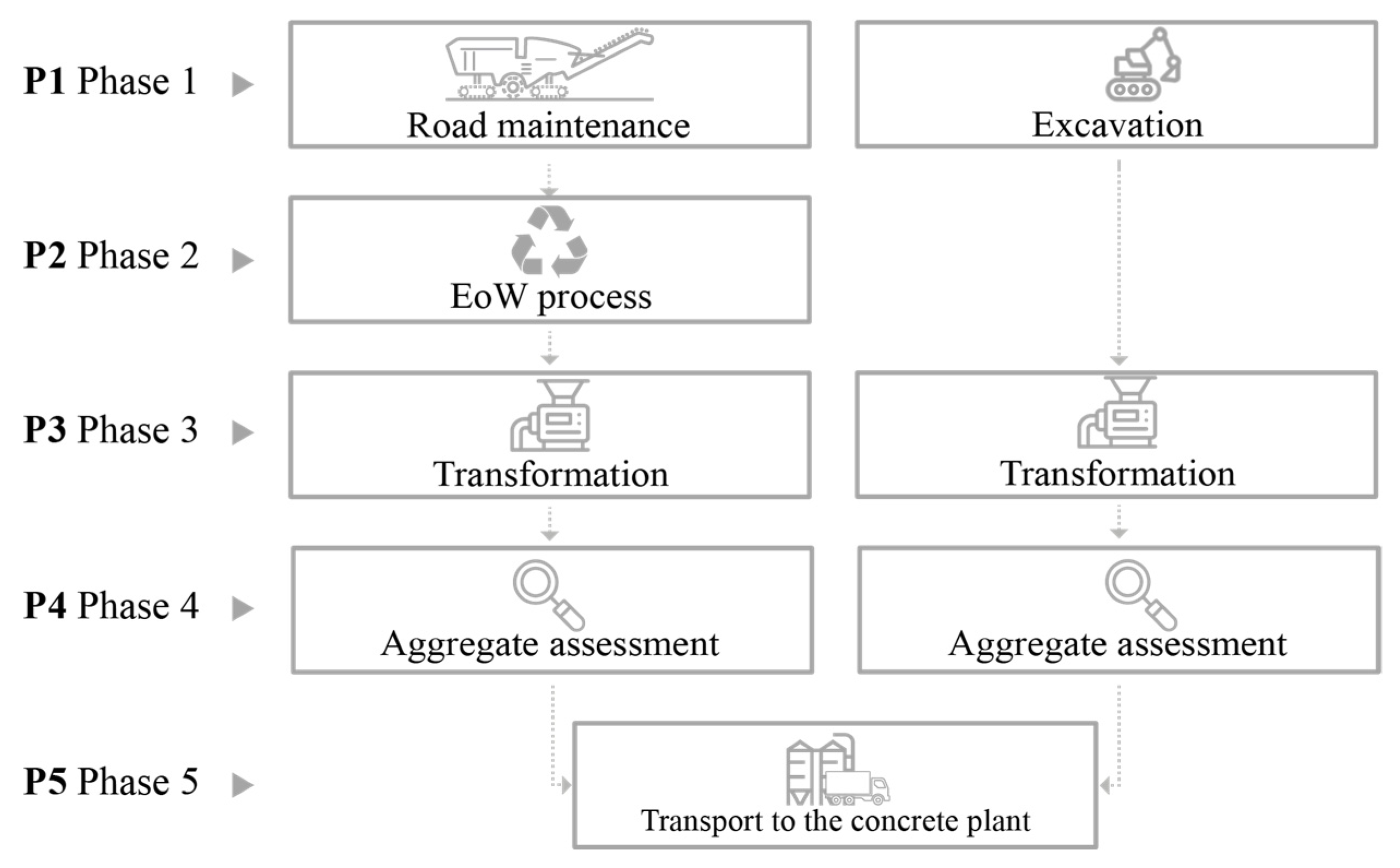
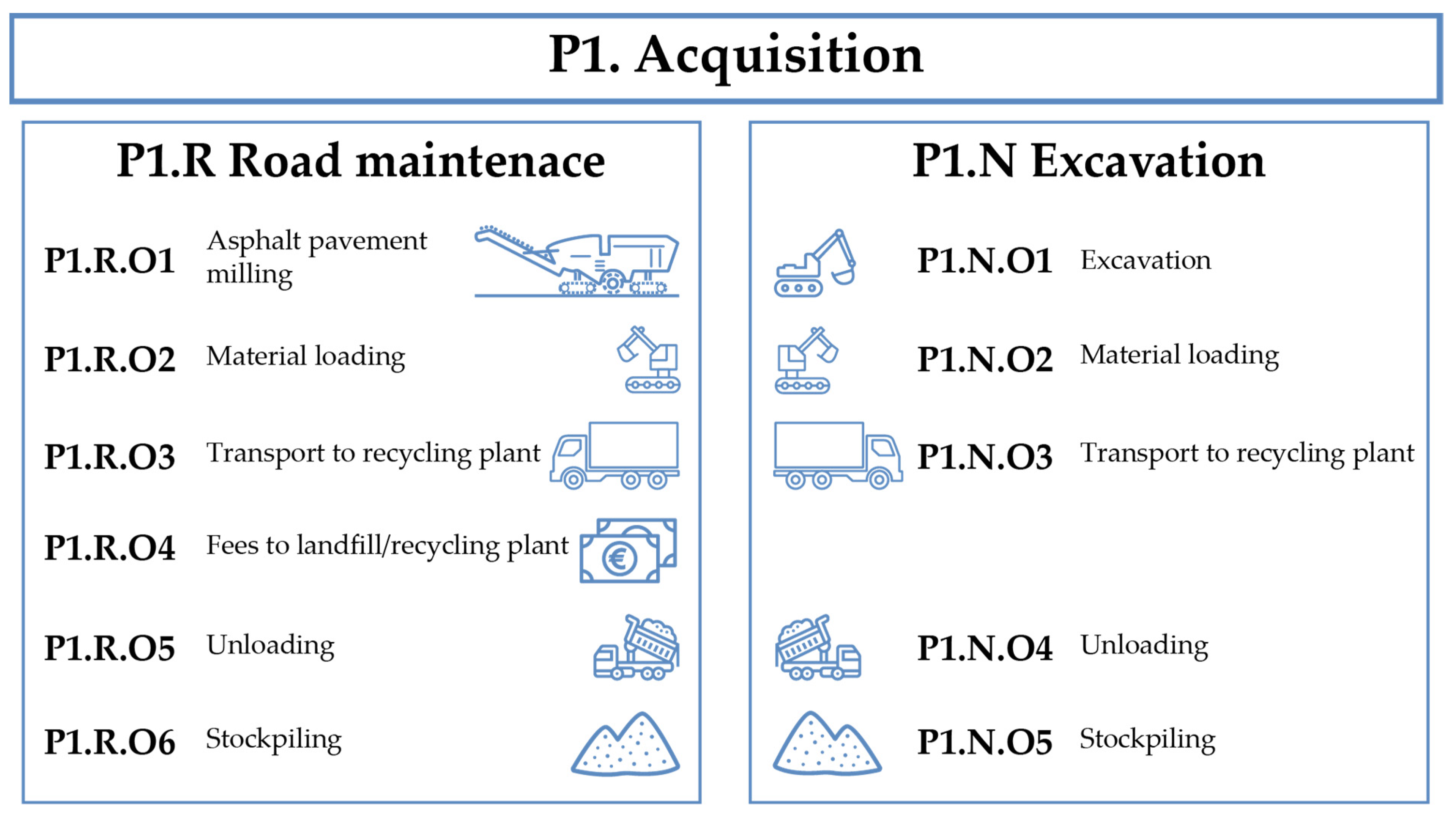

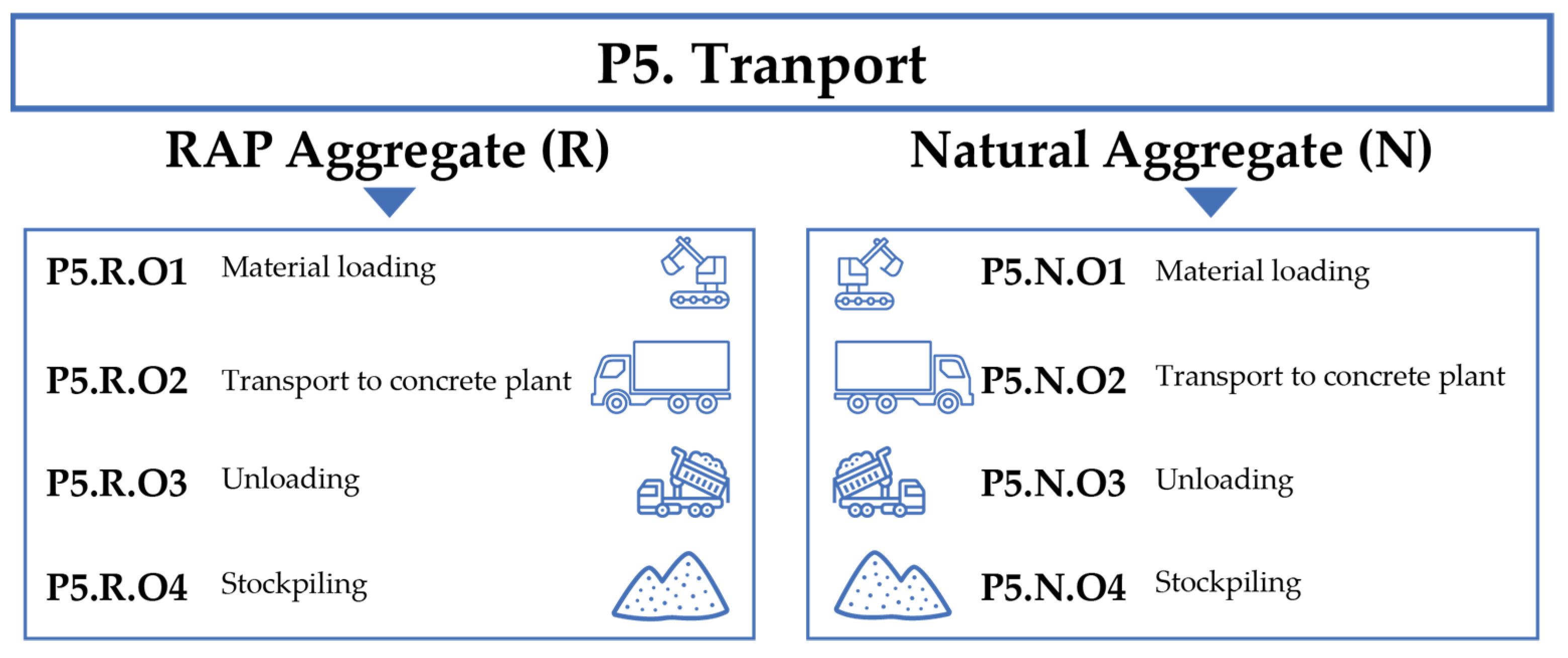


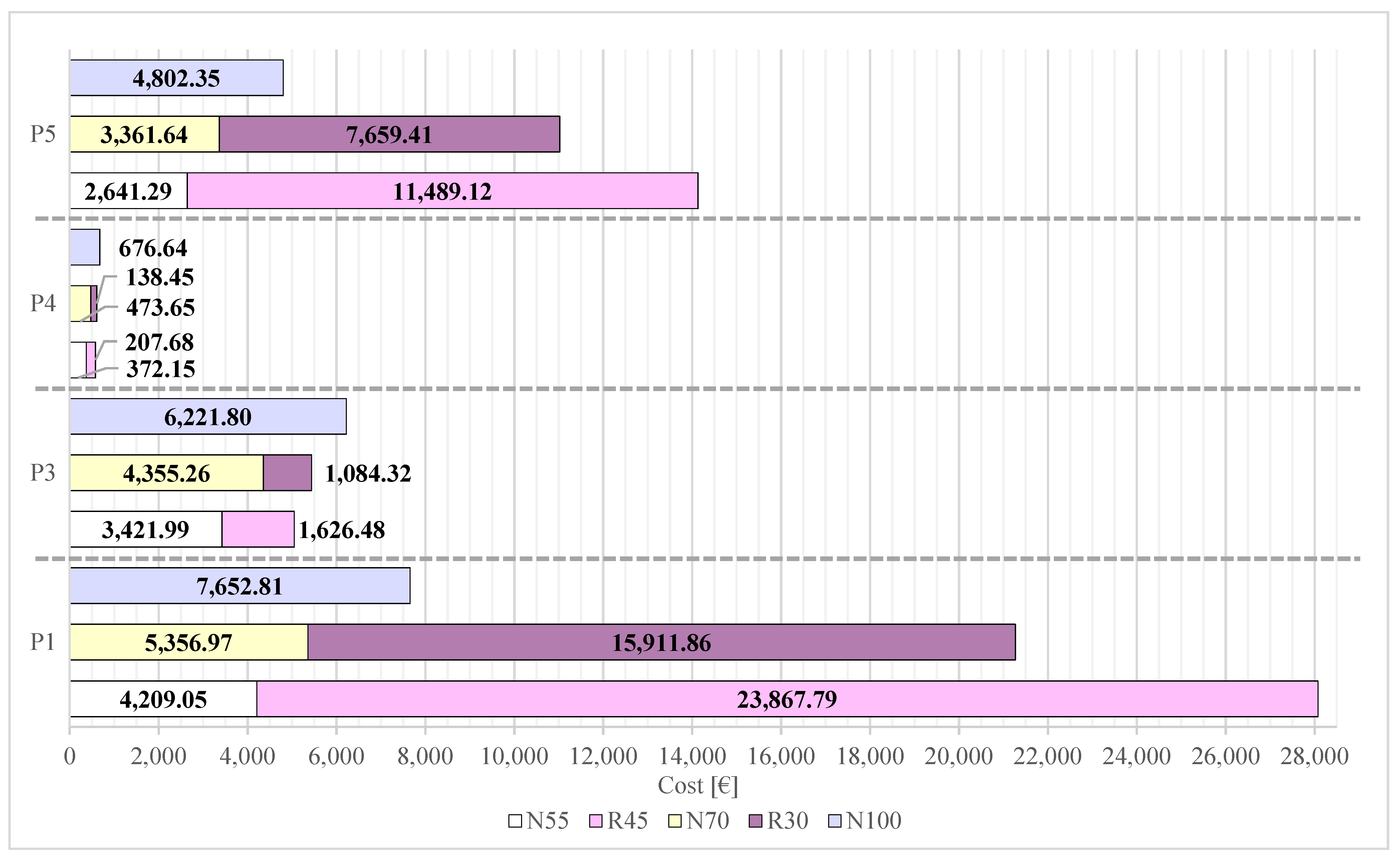

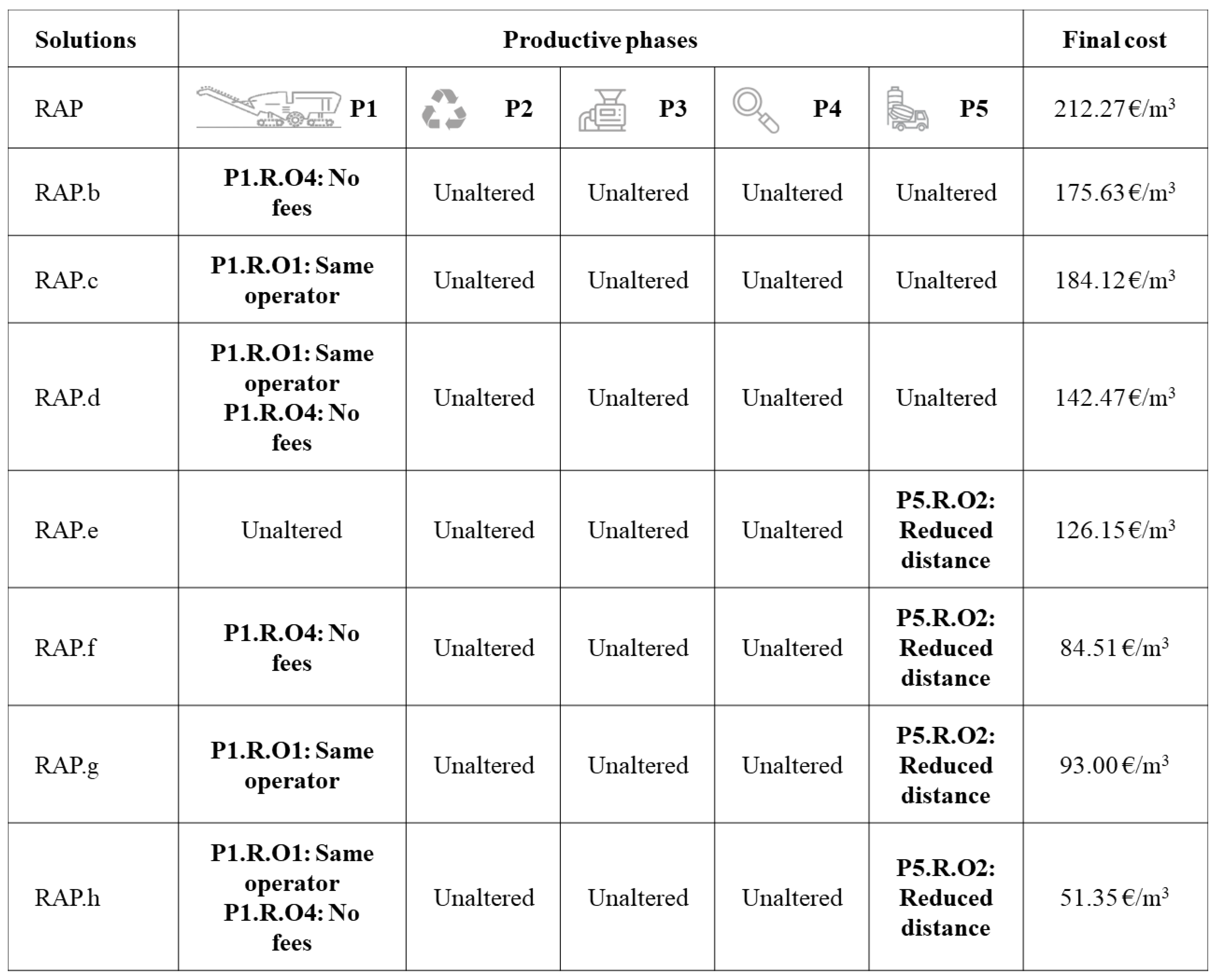
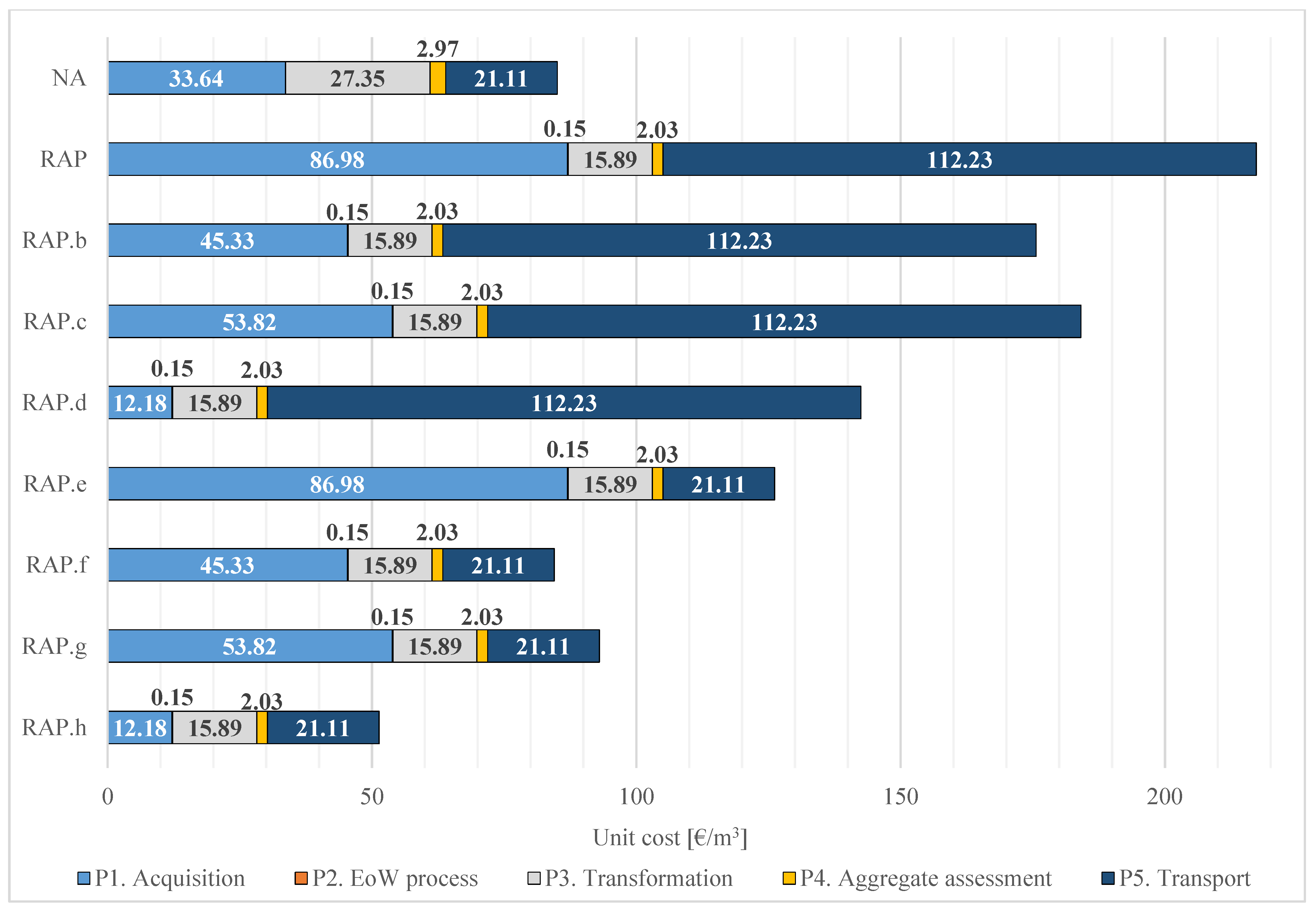

| Aggregate Type | Energy Consumption [MJ/ton] | CO2eq [kg/ton] |
|---|---|---|
| NA | 28.2 [48]–54 [18] | 7.8 [48]–10 [18] |
| RCA | 59.9 [48] | 12.9 [48] |
| RAP | 16.5 [18] | 1.3–2.3 [49] |
| Level | Height [m] | Components Dimensions [cm] | ||
|---|---|---|---|---|
| Foundations | Beams | Columns | ||
| −1 | 0 | 150 × 60 | - | - |
| 0 | 3.70 | - | 30 × 65 | 30 × 70 |
| 1 | 6.75 | - | 30 × 65 | 30 × 70 |
| 2 | 9.80 | - | 30 × 60 | 30 × 65 |
| 3 | 12.85 | - | 30 × 60 | 30 × 65 |
| 4 | 15.90 | - | 30 × 55 | 30 × 60 |
| 5 | 18.95 | - | 30 × 55 | 30 × 60 |
| 6 | 22.00 | - | 30 × 55 | 30 × 60 |
| Structural Components | Volume [m3] |
|---|---|
| Beams | 186.94 |
| Columns | 82.19 |
| Foundations | 120.51 |
| Total | 389.64 |
| Parameter | Value |
|---|---|
| Exposure class | XC1 |
| Strength class | C28/35 |
| Consistency class | S4 |
| Dmax | 15 mm |
| Max w/c ratio | 0.60 |
| Mix Name | Cem. Type | Rck [N/mm2] | Target Strength [N/mm2] | Consistency Class | w/c | Dmax [mm] | Water vol. [L/m3] | Air vol. [L/m3] | Cem. Content [kg/m3] | Cem. vol. [L/m3] | Agg. Type | Agg. Content [%] | Agg. vol. [L/m3] | Agg. Content [kg/m3] |
|---|---|---|---|---|---|---|---|---|---|---|---|---|---|---|
| N100 | CEM II 42.5 R | 35 | 38.5 | S4 | 0.45 | 15 | 227.5 | 2.13 | 505.56 | 167.40 | NA | 100 | 583.85 | 1582.23 |
| RAP | 0 | 0 | 0 | |||||||||||
| N70R30 | CEM II 42.5 R | 35 | 38.5 | S4 | 0.45 | 15 | 227.5 | 2.13 | 505.56 | 167.40 | NA | 70 | 408.69 | 1107.56 |
| RAP | 30 | 175.15 | 288.30 | |||||||||||
| N55R45 | CEM II 42.5 R | 35 | 38.5 | S4 | 0.45 | 15 | 227.5 | 2.13 | 505.56 | 167.40 | NA | 55 | 321.12 | 870.22 |
| RAP | 45 | 262.73 | 432.46 |
| Aggregate Type | N100 | R30N70 | R45N55 |
|---|---|---|---|
| NA | 19,353.60 € | 13,547.52 € | 10,644.48 € |
| RAP | 0 € | 24,804.28 € | 37,206.42 € |
| TOT | 19,353.60 € | 38,351.80 € | 47,850.90 € |
Disclaimer/Publisher’s Note: The statements, opinions and data contained in all publications are solely those of the individual author(s) and contributor(s) and not of MDPI and/or the editor(s). MDPI and/or the editor(s) disclaim responsibility for any injury to people or property resulting from any ideas, methods, instructions or products referred to in the content. |
© 2023 by the authors. Licensee MDPI, Basel, Switzerland. This article is an open access article distributed under the terms and conditions of the Creative Commons Attribution (CC BY) license (https://creativecommons.org/licenses/by/4.0/).
Share and Cite
Peduzzi, A.; Franco, A.; De Luca, G.; Coppola, O.; Bonati, A. Economical Assessment of Recycled Asphalt Pavement (RAP) Aggregate for Structural Concrete Production in Italy. Buildings 2023, 13, 2191. https://doi.org/10.3390/buildings13092191
Peduzzi A, Franco A, De Luca G, Coppola O, Bonati A. Economical Assessment of Recycled Asphalt Pavement (RAP) Aggregate for Structural Concrete Production in Italy. Buildings. 2023; 13(9):2191. https://doi.org/10.3390/buildings13092191
Chicago/Turabian StylePeduzzi, Arianna, Annalisa Franco, Giuseppina De Luca, Orsola Coppola, and Antonio Bonati. 2023. "Economical Assessment of Recycled Asphalt Pavement (RAP) Aggregate for Structural Concrete Production in Italy" Buildings 13, no. 9: 2191. https://doi.org/10.3390/buildings13092191
APA StylePeduzzi, A., Franco, A., De Luca, G., Coppola, O., & Bonati, A. (2023). Economical Assessment of Recycled Asphalt Pavement (RAP) Aggregate for Structural Concrete Production in Italy. Buildings, 13(9), 2191. https://doi.org/10.3390/buildings13092191








